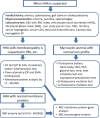Molecular diagnosis of hereditary spherocytosis by multi-gene target sequencing in Korea: matching with osmotic fragility test and presence of spherocyte
- PMID: 31122244
- PMCID: PMC6533652
- DOI: 10.1186/s13023-019-1070-0
Molecular diagnosis of hereditary spherocytosis by multi-gene target sequencing in Korea: matching with osmotic fragility test and presence of spherocyte
Abstract
Background: Current diagnostic tests for hereditary spherocytosis (HS) focus on the detection of hemolysis or indirectly assessing defects of membrane protein, whereas direct methods to detect protein defects are complicated and difficult to implement. In the present study, we investigated the patterns of genetic variation associated with HS among patients clinically diagnosed with HS.
Methods: Multi-gene targeted sequencing of 43 genes (17 RBC membrane protein-encoding genes, 20 RBC enzyme-encoding genes, and six additional genes for the differential diagnosis) was performed using the Illumina HiSeq platform.
Results: Among 59 patients with HS, 50 (84.7%) had one or more significant variants in a RBC membrane protein-encoding genes. A total of 54 significant variants including 46 novel mutations were detected in six RBC membrane protein-encoding genes, with the highest number of variants found in SPTB (n = 28), and followed by ANK1 (n = 19), SLC4A1 (n = 3), SPTA1 (n = 2), EPB41 (n = 1), and EPB42 (n = 1). Concurrent mutations of genes encoding RBC enzymes (ALDOB, GAPDH, and GSR) were detected in three patients. UGT1A1 mutations were present in 24 patients (40.7%). Positive rate of osmotic fragility test was 86.8% among patients harboring HS-related gene mutations.
Conclusions: This constitutes the first large-scaled genetic study of Korean patients with HS. We demonstrated that multi-gene target sequencing is sensitive and feasible that can be used as a powerful tool for diagnosing HS. Considering the discrepancies of clinical and molecular diagnoses of HS, our findings suggest that molecular genetic analysis is required for accurate diagnosis of HS.
Keywords: Hereditary spherocytosis; Molecular diagnosis; RBC membrane disorder.
Conflict of interest statement
The authors declare that they have no competing interests.
Figures




Similar articles
-
Identification of new mutations in patients with hereditary spherocytosis by next-generation sequencing.J Hum Genet. 2020 Apr;65(4):427-434. doi: 10.1038/s10038-020-0724-z. Epub 2020 Jan 24. J Hum Genet. 2020. PMID: 31980736 Clinical Trial.
-
Genotype-degree of hemolysis correlation in hereditary spherocytosis.BMC Genomics. 2023 Jun 6;24(1):304. doi: 10.1186/s12864-023-09364-8. BMC Genomics. 2023. PMID: 37280519 Free PMC article.
-
Novel mutation in alpha-spectrin gene in Saudi patients with hereditary spherocytosis.Nucleosides Nucleotides Nucleic Acids. 2024;43(11):1282-1301. doi: 10.1080/15257770.2024.2310703. Epub 2024 Feb 6. Nucleosides Nucleotides Nucleic Acids. 2024. PMID: 38319988
-
[Molecular mechanism of hereditary spherocytosis].Pol Merkur Lekarski. 2006 Jan;20(115):112-6. Pol Merkur Lekarski. 2006. PMID: 16617750 Review. Polish.
-
Molecular Genetic Mechanisms of Hereditary Spherocytosis: Current Perspectives.Acta Haematol. 2018;139(1):60-66. doi: 10.1159/000486229. Epub 2018 Jan 22. Acta Haematol. 2018. PMID: 29402830 Review.
Cited by
-
Clinical and genetic diagnosis for 26 paitents with hereditary spherocytosis.Zhong Nan Da Xue Xue Bao Yi Xue Ban. 2023 Apr 28;48(4):565-574. doi: 10.11817/j.issn.1672-7347.2023.220390. Zhong Nan Da Xue Xue Bao Yi Xue Ban. 2023. PMID: 37385619 Free PMC article. Chinese, English.
-
A clinical and experimental study of adult hereditary spherocytosis in the Chinese population.Kaohsiung J Med Sci. 2020 Jul;36(7):552-560. doi: 10.1002/kjm2.12198. Epub 2020 Mar 5. Kaohsiung J Med Sci. 2020. PMID: 32133777 Free PMC article.
-
Korean clinical practice guidelines for the diagnosis of hereditary hemolytic anemia.Blood Res. 2022 Jun 30;57(2):86-94. doi: 10.5045/br.2022.2021224. Epub 2022 May 20. Blood Res. 2022. PMID: 35593002 Free PMC article. Review.
-
Epidemiological Study of Hereditary Hemolytic Anemia in the Korean Pediatric Population during 1997-2016: a Nationwide Retrospective Cohort Study.J Korean Med Sci. 2020 Aug 24;35(33):e279. doi: 10.3346/jkms.2020.35.e279. J Korean Med Sci. 2020. PMID: 32830468 Free PMC article.
-
Thrombotic thrombocytopenic purpura developed after pegylated interferon treatment for hepatitis B infection.BMC Nephrol. 2022 Dec 13;23(1):400. doi: 10.1186/s12882-022-03034-9. BMC Nephrol. 2022. PMID: 36513992 Free PMC article.
References
-
- Iolascon A, Del Giudice EM, Perrotta S, Alloisio N, Morlé L, Delaunay J. Hereditary spherocytosis: from clinical to molecular defects. Haematologica. 1998;83(3):240–257. - PubMed
Publication types
MeSH terms
Substances
Grants and funding
LinkOut - more resources
Full Text Sources
Research Materials
Miscellaneous

